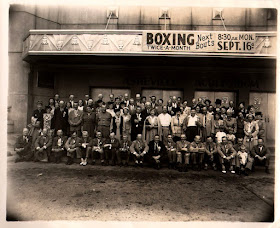Monday, January 31, 2011
Mount Hermon Masonic Lodge 118 (Asheville, North Carolina)
As historian at a Freemasons lodge in Asheville, Mark Bennett wants to make something clear. Despite the impression given by books like author Dan Brown's “The Da Vinci Code” and “The Lost Symbol” and movies like “National Treasure,” the Masons are not a clandestine group. “We're not a secret society,” Bennett says. “We're a society with a few secrets.” A once closed group whose members populated the power-elite from town hall to the White House, Masons are opening their doors to the public in increasing numbers in an effort to dispel myths and boost lagging membership. The Masonic Service Association of North America say membership levels are the lowest in 80 years, despite a bigger share of the public's consciousness thanks to the popular books and movies. There are fewer Masons today — by nearly a million — than there were in 1941 as the country came out of the Great Depression. The fraternity has an estimated 3 million members worldwide, said Richard Fletcher, the association's executive secretary. It had more than 4 million members in the U.S. alone in 1959. Today it has about 1.5 million, he said.
Tuesday, January 18, 2011
Farmer Russ WSKY Radio
Anyone who lived in Asheville NC and its environs from 1930 til the 70's probably knows Farmer Russ (Russ Offhaus). He provided the wake-up call for everyone who listened to WSKY radio, beginning at 5 am and continuing until 10 am. As the back of the postcard says "Farmer Russ is one of the real radio veterans. Starting in 1930 and "still hanging on....."
Thursday, January 13, 2011
Monday, January 10, 2011
Zebulon B. Vance Postal Cover 27 December 1860
This cover carried a December 27, 1860 letter to Walter Waighstill Lenoir. It was from his friend and classmate at the University of North Carolina, and then congressman from North Carolina, Zebulon Baird Vance. The cover was free franked with his signature. The contents describe the efforts of the moderate members of Congress to form a Middle Confederacy for the purpose of keeping the two extremes separate and from fighting each other.
"Ashville" Postal Cover 1880
All postage stamps printed and put into service by the United States are still valid for postage with the exception of the series of 1847 issue which became invalid when the second issue became available on 1 July 1851, and the series of 1851 which was demonetized in 1861 to prevent its use in the Confederacy. An illustration of this is a cover postmarked ASHVILLE/N.C./AUG/9/1880. It was franked with a 3¢ issue of 1857-61 which someone probably found stuck away. The postage stamp was canceled with a circular handstamp reading, "HELD FOR POSTAGE", meaning that it was 3¢ postage due. Note spelling of "Ashville."
The first Asheville postmaster, Mr. Patton, was appointed 8 October 1800. This probably was James Patton (1756-1846), for whom Patton Avenue in Asheville is named, or Colonel John Patton (1765-1831).
Sunday, January 9, 2011
Saturday, January 8, 2011
Friday, January 7, 2011
"The Spring"
_______________
"The Spring on Trail Near Grove Park Inn (Asheville, North Carolina).
William Jennings Bryan on a Trip to Mt. Pisgah
_______________
A trip over the exclusive automobile road, seventeen miles long, to Mt. Pisgah, built by Mr. George W. Vanderbilt at a cost of $51,000, is one of the rarest treats afforded the visitors to Asheville. The distance from Asheville to the entrance of this great automobile highway is twelve miles over a fine improved road, seven miles of which is macadam with five miles of sand-clay.
"Me and Grandma" 1903
_______________
"The chain is indeed a beauty, and I mean to keep it always as someday it will be a curiosity. I am very busy but will write a letter soon. My eyes are about all right. Love to all. Yours, B. 1-7-04."
Beaver Lake (Asheville, North Carolina)
_______________
Beaver Lake in Lakeview Park (Asheville, North Carolina): This is a sparkling body of clear mountain water, about 65 acres in extent. The most striking natural advantage of Lakeview Park is the unobstructed outlook toward the sheltering mountain ranges in all directions, and the distant views of towering peaks to the North and West.
Tuesday, January 4, 2011
Bringing in the Dead: North Carolina Civil War Deaths
Bringing in the Dead: The North Carolina Civil War Death Study: Free Public Lecture 25 January 2011 (Noon - 1 p.m. 1st floor of the Government and Heritage Library, 109 E. Jones Street, Raleigh). Josh Howard of the Research Branch of the N.C. Office of Archives and History will discuss his research on the N.C. Civil War Death Study.
Telephone: (919) 807-7450
Email: rebecca.hyman@ncdcr.gov
Website: www.ghlblog.org
_______________
"The project encompasses reviewing the military records, as well as archival and newspaper accounts of military deaths during the American Civil War amongst North Carolina Confederate and Union units. The project also reveals for the first time ever the number of black and white North Carolinians who died in Union service within North Carolina's total losses, which prior to now have only focused on the Confederate troops."
_______________








































